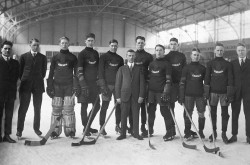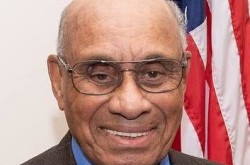James Naismith and the Invention of Basketball
This article was originally written and submitted as part of a Canada 150 Project, the Innovation Storybook, to crowdsource stories of Canadian innovation with partners across Canada. The content has since been migrated to Ingenium’s Channel, a digital hub featuring curated content related to science, technology and innovation.
The Invention of an International Sport
In 1891, two peach baskets, an old soccer ball and cold weather resulted in one of the world’s most popular sports today.
Dr. James Naismith studied physical education at McGill University before teaching that same subject at YMCA Training School in Springfield, Massachusetts.
The harsh New England winters meant it was too cold to go outside and play sports. Naismith’s class was particularly rowdy and without an outlet for their energy, it would only get worse. His students needed something to keep them busy during the colder months.
Under instruction from the schools Head of Physical Education, Naismith was given two weeks to create a safe sport to play indoors. He experimented with variations of other popular games but all were too rough. So, for his new game, he came up with 13 basic rules. Most of them were to limit the chance of people getting hurt. Some included that passing was the only way to move the ball and striking at the ball would result in a foul.
Naismith nailed peach baskets to the walls, 10 feet high, at opposite ends of the gym. The height was meant to prevent students from attempting to guard the goal and getting injured. Once his students arrived for class, he separated them into teams of nine and the first game of basketball began.
Evolution of the Net
Keep in mind that when basketball first started, peach baskets weren’t exactly the ideal instrument to use. Originally, whenever anyone scored a goal by throwing the ball into the basket, the ball would have to be retrieved by hand. This required the janitor to get his ladder, climb up and take the ball out.
Eventually, a small hole was cut in the bottom of the basket so that a stick could pop the ball out from underneath.
It wasn’t until 1906 that a more modern hoop with a net and backboard was used.
Basketball Legacy
In 1898 Dr. James Naismith arrived at Kansas University and took on the role of the first-ever campus basketball coach. By the turn of the century, basketball grew so popular that intercollegiate play was possible.
In the year of 1936 basketball was played at the Olympics for the first time. Dr. Naismith presented the medals to the winners – in which Canada won silver – and was named Honorary President of the International Basketball Federation. He also wrote the original basketball rules, which were fewer than 600 words. Today’s rules contain over 30,000.
Naismith is honored with a number of awards in his name that are presented every year in the National Basketball Assocation (NBA) and the National Collegiate Athletic Association (NCAA).
A few of his most notable accolades include the Naismith Memorial Basketball Hall of Fame in Massachusetts and a statue in his birth-town of Almonte, Ontario.
Life and Death
James Naismith was born in Almonte, Ontario – just outside of Ottawa – in 1861 to parents John and Margaret Naismith. Orphaned at the age of nine, due to his parents becoming ill, Naismith was raised by his aunt and uncle.
Despite never being a strong student, he managed to graduate high school and later attend McGill University to study physical education.
At McGill he was a multi-sport athlete who played lacrosse, football, rugby, soccer and he excelled in gymnastics.
After his career at McGill he moved to Springfield, Massachusetts where he got a job as a physical education teacher. He became the Athletics Director at the University of Kansas until he passed away in 1937.
Naismith was 78 when he passed away from a brain hemorrhage.
He’s buried at Memorial Park Cemetery in Lawrence, Kansas.





![Radio, Receiver Source: Ingenium [Artifact no. 2001.0320.001]](/sites/default/files/styles/thumbnail_7/public/2019-06/radio1.png?h=bb5d882f&itok=Zk95qLNH)












